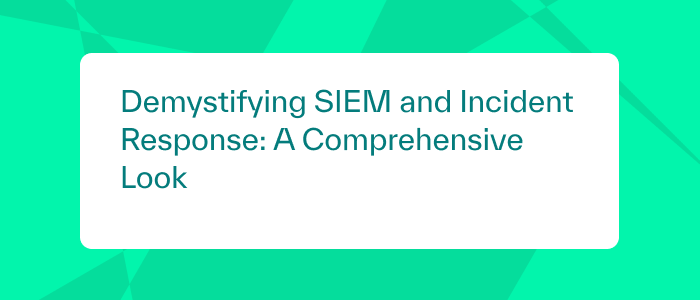The Significance of Incident Response
Critical Components of Incident Response in SIEM

Security Information and Event Management (SIEM) solutions and Incident Response (IR) play pivotal roles in fortifying an organization’s cyber defense strategies. This comprehensive guide aims to shed light on these crucial components and provide valuable insights and best practices to empower organizations in safeguarding their digital assets.
SIEM solutions act as the central nervous system of an organization’s cybersecurity infrastructure. They are designed to collect and analyze security-related data from diverse sources within an organization’s IT ecosystem, including event log data from users, endpoints, applications, data sources, cloud workloads, and networks. Leveraging SIEM solutions offers several key benefits:
Incident Response (IR) encompasses the approach used to manage security incidents, reducing the damage to an organization and improving the recovery of affected services or functionalities. In today’s evolving threat landscape, IR has become increasingly crucial, with the following key considerations:
Effective incident response within SIEM systems involves a series of crucial components, including event collection, correlation and analysis, incident detection, alert prioritization, incident investigation, threat validation, incident containment and eradication, remediation and recovery, and post-incident analysis.

In conclusion, SIEM solutions and Incident Response are vital components of a robust cybersecurity strategy, providing organizations with the necessary insights to stay ahead of evolving threats and effectively respond to security incidents. Embracing these technologies is essential in fortifying defenses and protecting sensitive data from the ever-present dangers of the cyber world.
Gurucul’s Next-Gen SIEM enhances incident response by offering advanced analytics and machine learning to quickly detect and prioritize threats. By leveraging User and Entity Behavior Analytics (UEBA), it identifies anomalies and uncovers hidden risks, enabling faster detection of suspicious activities. The platform’s automation capabilities streamline response actions, reducing manual workload and accelerating the incident lifecycle from detection to resolution. Additionally, its real-time visibility and customizable dashboards help security teams make informed, timely decisions, allowing for a more proactive and efficient approach to mitigating incidents before they escalate.

This comprehensive guide aims to give readers a deep understanding of SIEM and incident response, offering valuable insights and best practices to fortify their cybersecurity strategies.
For more information, visit Gurucul Technical Training.
This blog post is intended to serve as a comprehensive guide for organizations aiming to bolster their cybersecurity posture through effective SIEM and incident response practices. By understanding the critical role of these components and embracing best practices, organizations can proactively safeguard their digital assets and mitigate potential security risks in today’s dynamic threat landscape.
